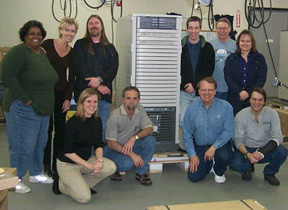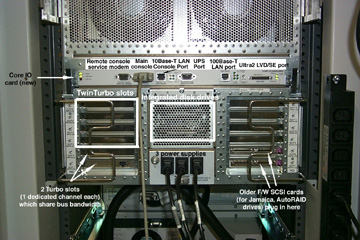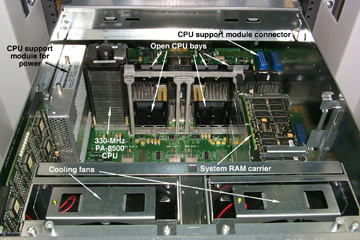 |
Click for Adager Sponsor Message |
| April
2001
N-Class systems fan out into customer base Revamped IO design prompts changes in configurations The first N-Class HP e3000 rolled off the loading dock of North American distributor Client Systems late last month, kicking off an era of expanded potential for the 28-year-old business servers. The first N4000 unit went out to reseller Southeastern Data Systems, which was set to install the system with application software for Warren Rural Electric Corp. The N4000 330MHz single-processor unit was one of more than a dozen systems Client Systems shipped in the first week of release for the first PCI-based 3000s.
That PCI connectivity is at the heart of many of the improvements in the newest HP 3000s. Duane Percox of e3000 ISV Quintessential School Systems, a vendor which had two systems shipping in the first group of N4000s from Client Systems, said that tests of an N4000 single-processor 330MHz box showed database loading speeds which reflected the power of the new IO. “It was very fast,” he said. “I brought a customer database, scrambled which they let us put on the system, but it was pretty big. We have disk to disk database unload, and it took a whopping four minutes to unload and seven minutes to reload.” Percox ran a 123-page, 50-lines-per-page report of vendors on the system which finished before he could look for it. “The program launched the report and returned back to my main menu — and when I went into the print spooler, and the report was there.” The extra speed comes at thousands less than prior e3000 offerings, Percox said. He compared a bid of a Series 929/030 system for a customer who got to take delivery of an N4000 system instead. “It spec-ed out at about $60,000 less, and performance was a 9, instead of a 3.7. The customer thought that was a pretty good deal.” Changes to disk Customers will have someplace to apply part of those savings. The IO changes in the N-Class and its A-Class counterparts are profound enough that most customers won’t be able to reuse existing internal disk drives from the their 9x9, 99x or 9x8 systems. Buying an N-Class means budgeting for disk for most customers. That’s because those older systems use High Voltage single-ended or fast/wide SCSI peripheral interfaces, things the newest N-Class boxes only support as an external device. It means that plugging an existing DDS tape drive into the newest 3000s is easily done, but any such SE device it will only use a fraction of the available IO bandwidth.
External disks from the current 3000 line are supported, however. Jamaica disk arrays, HVD10s and F/W SCSI external disks can be used. The newest HP e3000s have much higher bandwidth available through their LVD interfaces, but for the time being there are no disks certified for 3000s which use the LVD interface. HP has promised that it’s working on supplying such devices, along with the long-awaited native Fiber Channel IO, but it hasn’t committed to a release date for either the devices or the IO. In the meantime Fiber Channel arrays from the XP line, the XP512 and XP48, will be supported using a Fiber Channel to SCSI adapter starting with MPE/iX 7.0 Express 1. These newest AutoRAID arrays will be able to be used as boot devices on the e3000’s N-Class. New disks for the systems are offered in 9Gb, 18Gb and 36Gb sizes, priced from $1,122 to $3,060. The disks are different for N-Class and A-Class systems, and cannot be interchanged. But for the first time in the 3000 lineup’s history, a customer can order a 3000 from the factory with no internal disk drive installed. The total number of drives supported on the N-Class systems is actually less than that of the 997 systems already in the customer base. A dozen slots are available on the N-Class systems for peripherals, and 10 of them can be configured as Twin Turbo to accommodate two peripherals. Including the two IO channels on the system’s Integrated Multifunction IO board, the total peripheral device count can then be 24; in contrast, up to 56 peripherals can be attached to the 997 systems.
However, HP designed the N-Class systems with faster disks and higher capacities in mind. Their Low Voltage Differential/SE interface transfer rates peak out at 80Mb/second, four times faster than the limits of the 997 systems. And HP intends for RAID arrays, with many disks per device, to serve the needs of N-Class customers who require a lot of disk capacity. While some customers prefer a higher number of spindles and lower capacities per drive — for better availability — performance in that type of configuration could well be less than the faster-RPM, greater capacity RAID arrays available with the N-Class. The N-Class systems come with an Ultra2 LVD/SE SCSI port that’s separate from the system’s internal disk ports, a port designed to let customers plug in existing tape drives. HP is recommending DDS-3 tape devices, but a DDS-2 unit will also work, although it’s not on HP’s supported devices list for the N-Class. The new Integrated Multifunction Core IO Card holds this Ultra2 LVD/SE SCSI port, as well as a 10/100Base-TX port and an RS-232 port. There’s more: two Ultra SCSI ports which will support HotPlug IO devices when HP adds that functionality to the e3000; a local serial console port for a UPS; a 10Base-TX LAN console port; and a serial modem port round out the Core IO Card functionality. The card won’t be functioning at all until the Express 1 release of MPE/iX 7.0, so HP is including a free networking card in the earliest shipments of the N-Class systems. On the N-Class systems, four memory carriers hold eight DIMM slots per carrier to let customers stock up to 16Gb of RAM in the newest 3000s. However, HP is holding down memory support to 2Gb until that Express 1 7.0 release. HP’s memory pricing is still far above third-party options, and there are plenty of options out there. The N-Class HP 9000 units use the same memory as the HP e3000 systems, so suppliers like Newport Digital can offer N-Class memory at thousands less than HP’s list prices. One gigabyte of RAM from HP runs $9,380, and is priced at under $2,000 from Newport Digital. N-Class memory is different from A-Class memory. HP’s list prices for its N-Class systems include base memory configurations far in excess of prior systems. Three-processor and four-processor N-Class systems come with 3Gb of memory, and the twin-processor N4000-200-440 comes with 2Gb of memory. Single processor N4000s come with 512Mb for the 220- and 330-MHz models, while the 440-Mhz single-processor systems come with 1Gb of base memory. The N-Class doesn’t let customers mix differing types of processors. That means that it’s either all 440-MHz or all 550-MHz CPUs for N-Class owners. HP has announced support for up to eight processors in the future for the N-Class e3000s. |
Copyright The 3000 NewsWire. All rights reserved.



